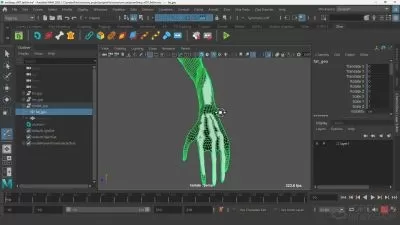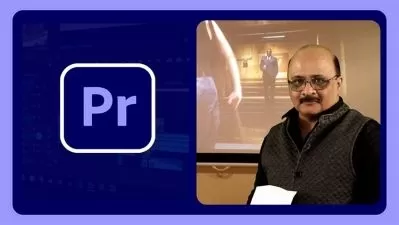How to View and Appreciate Great Movies
Eric R. Williams
13:17:20
Description
You may sometimes wonder why a single scene from a movie stays with you long after the credits roll, yet in other cases, you can't recall if you've even seen an entire film. Thinking about that memorable moment, what made that impression? Was it a particularly well-acted scene? The dramatic lighting? The emotion of the music? The tension that has built up? The ability to relate to the situation? A powerful choice of words? The answer is, simply, yes.
Understanding the intent of every aspect of a movie—from lighting to language, color to characters, stars to scores—can help you not only appreciate the movies you're watching at a much more profound level but also open your eyes to the multitude of ways you're being manipulated from the moment you sit down in the theater. A great filmmaker controls every sensation the movie evokes—tremors or tears, goosebumps or giggles. And while this may feel orchestrated when you begin to pull back the curtain and discover the secrets behind making great movies, you'll also learn why we invite and welcome that manipulation.
Join professional filmmaker, author, and award-winning professor, Eric R. Williams, as he takes you behind the scenes with How to View and Appreciate Great Movies, sharing the concepts that he has developed as a professional filmmaker over the last 25 years. As he walks you through 250 different titles―some well-known, others less so―you'll explore how every step of a movie is a choice and each choice has a significant impact on consciously and subconsciously influencing the audience.
View old favorites through a new lens including:
- Casablanca
- Citizen Kane
- Jaws
- The Godfather
- Wizard of Oz
- Star Wars
- Rocky
- Do the Right Thing
- Silence of the Lambs
- Apocalypse Now
You'll unpack and examine the screenwriting, story building, sound choices, set design, lighting, special effects, editing, scores, characters, and more for these movies and hundreds of others. Each facet of filmmaking is controlled independently, and Professor Williams will demonstrate the essential step of amalgamating every perspective into a collaborative―if not unified―view, resulting in a symphony of creative decision-making. This process doesn't always succeed, but when it does, it leaves a lasting impression.
Generalizations about Genres
Before diving into the nuts and bolts of filmmaking, Professor Williams zooms back for a wide-angle look at the bigger picture of films: the notion of genre. If you use Netflix to measure film genres, you might believe there are thousands of them. In fact, Netflix has categorized more than 27,000 genres—from “20th-Century Period Pieces for Hopeless Romantics” to “Feel-good Deep Sea Movies for Ages 8 to 10.” Once you start subdividing and adding in niche interests, the number seems limitless.
With this course, Professor Williams challenges the idea that there are a myriad of genres by redefining what a genre is, down to the nitty-gritty of establishing the difference between “action” and a “thriller.” He'll break down how and why you can use genres to better find, understand, and appreciate movies as he introduces you to the concepts of super genre, macrogenres, and microgenres.
Perhaps one of the most interesting revelations concerning genres is when Professor Williams divulges how great movies can often use genre against us. A good filmmaker will know to how to anticipate an audience's expectations before they've even walked into a theater. If we signed up for a Romeo and Juliet experience, it better include: a couple overcoming obstacles; falling in love against all odds; and then the ultimate, albeit expected, tragic death of one or both of them. And the filmmaker knows we better make use of the tissues we brought with us because that is what we are expecting. When we don't—when the movie doesn't meet our preconceived expectations, it's not considered a “Great Movie.”
Or, is it?
As previously noted, filmmakers have the power to manipulate every single facet of our experience and sometimes by playing with the notion of what we predict, the surprise that results is just as satisfying as the conclusion we expected. Consider Psycho. This oft-lauded film starts off as a crime movie but turns into a horror movie when director Alfred Hitchcock [SPOILER ALERT] kills the protagonist (a huge star who was portrayed as being the main character, so you expect her to live through the entire film) at the end of the first act in cold blood.
Genre is not a steadfast rule. Expectations exist to be bent, twisted, broken, undone, exaggerated, minimized—most of all—controlled. And often, a great movie will take the stereotypes you associate with the genre and will surprise you by turning them on their head. Or, sometimes it will blend genres. Or, it might start as one genre and end as another. It's no wonder we readily accept there are 27,000 genre possibilities—that's the filmmakers playing with us again.
Why Sights and Sounds Make Sense(s)
Seeing—and hearing—is believing, especially in the mystical world of movies where we are being asked to believe the unbelievable from the moment we sit down. How do you convince audiences that what Harry feels for Sally is true love, that the giant animatronic shark could be a real threat to anyone in water anywhere, or that super powers are not only possible but easily accessible to anyone with access to super-suits, special spiders, or Stark Industries? To paraphrase The X Files, we want to believe, but the filmmakers have to do their part to get us emotionally invested enough to want to believe. That investment involves building worlds that ensure our senses are satisfied with the experience, down to the smallest detail.
Spending more than half a dozen lectures on the nuts and bolts of movies, Professor Williams uncovers the tricks used to help us suspend our disbelief, let go of our cynicism, and buy in—including the use of sounds, scores, lighting, color, and special effects. You'll discover how even these seemingly small details can greatly enhance or detract from the theme, atmosphere, and story.
- Consider Sound. When you watch a storm on the screen, you expect to hear rain. But is the rain pounding or sprinkling? Is there wind? Is it romantic-kissing rain or a tension-building thunder storm? Discover how the intensity, realism, or lack of sounds in a scene can not only add to it but also can help define it.
- Consider Color. Would The Martian feel otherworldly if it was full of Earth's greens and blues? Would Do The Right Thing have the same visual impact if it was shot in black and white? Color choices are never unintentional because they alter how the audience sees the movie (literally and figuratively).
- Consider Location. There's a reason you rarely see ghost stories occur in modern condos—you need the spooky, creaky, dark, and broken old house to increase the fear factor. The house, in essence, becomes a character itself.
- Consider Score. You don't even need to see the giant animatronic shark to feel dread when you hear the iconic “Duh-nuh – duh nuh duh nuh – duh nuh duh nuh duh nuh.” The most terrifying moments of Jaws are not built with visuals but with music. Learn how scores provide the emotional architecture to the story.
- Consider Special Effects. The 3-D achievements of Avatar transported us INTO Pandora rather than showing us another planet, while the computer-generated imagery (CGI) in The Polar Express demonstrated the pitfalls that relying on technology can bring.
After viewing these lectures, the Academy Award categories for Editing, Cinematography, Sound Design, and more suddenly take on a whole new meaning. You'll go into movies with a new eye for detail and a deeper appreciation for the nuances and minutiae that create the bigger experience.
Acting!
Slap Adam Sandler's name on the trailer and chances are the movie will earn millions, regardless of plot, story, editing, or any of the other components that make great movies. And sometimes, that's all filmmakers do. While marketable and financially successful, those movies are rarely great.
Professor Williams spends several lectures delving into characters, actors, and relationships. Examining established archetypes and character types; sprinkling in Carl Jung, Joseph Campbell, and the psychology of a story; and looking at the vital role of the antagonist, you'll gain a deeper appreciation of how characters are built, what their purpose is in a story, and why different characters behave the way they do.
Some of the fascinating insights Professor Williams provides about characters include:
- The surprising way directors will intentionally cast stars for or against their expected “type” to reinforce or subvert our preconceived expectations.
- An antagonist is vital to every movie, no matter what the genre. However, the antagonist is not always a villain. He can be a friend, an organization, a stranger, an animal, an environment, or even the protagonist himself.
- All great villains are a distorted reflection of the hero.
- Supporting characters represent the hearts and souls of main characters and are essential to revealing what the main characters are not.
Meta Movie Making
One of the best components of How to View and Appreciate Great Movies is that this course about how movies are produced is a production in and of itself. Professor Williams takes a fun, tongue-in-cheek approach, often breaking the fourth wall, revealing tricks of the trade, and drawing parallels between filming a movie and filming the course.
Relaxed, engaging, self-deprecating, and charmingly personal, Professor Williams invites you into the set and his views with humor and warmth. You'll feel as if he were personally watching each movie with you and guiding you through the components of what made it great.
The information you take away from the course is invaluable to enhancing your appreciation of films and is presented in a way that is easy to adapt into your own viewing habits. You'll find yourself not only watching movies in a completely new way, but reviewing and talking about them from an entirely new and better-informed perspective.
Professor Williams often refers to filmmaking as a kind of magic trick—an illusion. And once you understand the trick, pull back the curtain, and go backstage—behind the camera, inside the script—to see the creative process from the filmmaker's point of view, the magic show can never be the same again. Knowing that no decision made in the film process is arbitrary and every component is engineered to maintain control and manipulate your reactions can feel like it might ruin your movie-going experience, but as you'll discover, it simply strengthens your love for what's unfolding before your eyes and gives you a new set of creative and analytical tools to bring with you to the movies.
Roger Ebert once said, “Every great film should seem new every time you see it” and that's exactly what How to View and Appreciate Great Movies ensures.
More details
User Reviews
Rating
Eric R. Williams
Instructor's CoursesEric R. Williams is a Professor in the School of Media Arts & Studies at Ohio University, where he teaches courses on screenwriting, film, and virtual reality production. He is also the director of the MFA in Communication Media Arts program at Ohio University. Professor Williams received his bachelor’s degree in Communication with a minor in Education from Northwestern University, and he earned his Master of Fine Arts degree in Film from Columbia University.
Before directing his first feature film, Professor Williams worked as a cinematographer and assistant director in New York City. He has written more than 30 screenplays. He has also written, produced, and directed for companies such as Workshop Productions, Liam Films, American Movie Classics, Fox Interactive, and Universal Studios.
Professor Williams’s films and screenplays have won the Best New Work award from the Writers Guild of America and the Individual Excellence Award in screenwriting from the Ohio Arts Council. His film Breaking News was selected as one of the “Top Five Films Not to Miss” by the Athens Independent Film Society at the Athens International Film and Video Festival. At Ohio University, he received the University Professor Award for excellence in teaching, and he was also a finalist for the Presidential Teacher Award.
Professor Williams co-edited the book Media and the Creative Process. He is also the author of two other books: Screen Adaptation: Beyond the Basics and The Screenwriters Taxonomy.
When he is not writing, producing, or directing, Professor Williams enjoys working on international media education projects and he frequently travels to South America and Eastern Europe. His dedication to teaching was recognized by the president of Guyana, where he was awarded a lifetime honorary membership to the CineGuyana society.

The Great Courses
View courses The Great Courses- language english
- Training sessions 24
- duration 13:17:20
- English subtitles has
- Release Date 2023/06/06



















